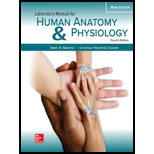
Which of the following is not a function of the integumentary system?
- protection
- excrete small amounts of waste
- movement
- aid in regulating body temperature
Introduction :
The integumentary system is an organ system consisting of the skin, cutaneous glands, hair, and nails. These structures provide a protective covering for deeper tissues, retard water loss, house sensory receptors, aid in regulating body temperature and excrete small quantities of waste.
Answer to Problem 1PL
Correct answer :
The correct answer is option (c) Movement.
Explanation of Solution
Explanation/justification for the correct answer :
Option (c) Movement.The skeletal system provides the body with physical support and helps in Movement. Skeletal muscles are attached to bones and have the ability to move them, thus facilitating movement. So, the correct answer is option (c).
Explanation for incorrect answer :
Option (a) Protection. Skin has a protective acidic film called the acid mantle (pH 4−6). It helps to keep the number of bacteria and fungi colonizing the surface under control. Protection against the pathogens that intrude the surface is provided by immune cells called dendritic cells in the epidermis. The epidermal cells of the skin are packed with the tough protein keratin and linked by strong desmosomes that give the epithelium its durability. So, this is an incorrect option.
Option (b) Excrete a small amount of waste. Sweat glands secrete sweat which contains mostly water but also contains wastes such as; sodium chloride, ammonia, urea, and uric acid. Sebaceous glands produce an oily secretion called sebum. Sebum consists of broken-down cells that are replaced by mitosis at the base of the gland. Ceruminous glands are found only in the auditory canal, where their secretion combines with sebum and dead epidermal cells to form earwax. So, this is an incorrect answer.
Option (d) Aid in regulating body temperature. Skin helps in thermoregulation. During cold times, thermoreceptors present in the dermis transmit signals to the brain, and the brain sends signals back to the dermal blood vessels. Vasoconstriction is the blood vessels that reduces the flow of blood close to the skin surface and thus reduces heat loss. When one is overheated, the vasodilation of the dermal blood vessels increases cutaneous blood flow and increases heat loss. So, this is an incorrect answer.
Want to see more full solutions like this?
Chapter 11 Solutions
Laboratory Manual for Human Anatomy & Physiology Main Version
- Identify the phylum or class. a. Euglenophyta b. Dinoflagellata c. Bacillariophyceae d. Oomycetes e. Phaeophyceae O f. Myxomycota g. Xanthophyceae ○ h. Chrysophyceae i. Dictyosteliomycota O j. Rhodophyta Ok. Chlorophyceaens I. Charophyceaensarrow_forwardWhat is produced inside the indicated structure (Fucus). a. eggs O b. antheridia ○ c. sperm d. zygotes e. none of thesearrow_forwardGreen Algae, as a group, is actually paraphyletic with one subgroup more closely related to higher plants than the other. Which of the following green algae groups is more closely related to higher plants: a. Charophyceans b. Chlorophyceans c. Rhodophyta d. Xanthophyceansarrow_forward
- A single-celled green algal genus that is motile with 2 flagella, has a cup shaped chloroplast, and an eyespot: a. Volvox b. Chlamydomonas c. Euglena d. Codiumarrow_forwardA[n] ___ is produced by members of the Myxomycota when there is a lack of moisture. a. plasmodiocarp b. aethalium c. sclerotium d. plasmodiumarrow_forwardWhich of the following is not true about the life-cycle of Fucus. a. 8 eggs per oogonium b. 64 sperm per antheridium c. eggs are flagellated d. sperm are flagellatedarrow_forward
- Green Algae, as a group, is actually paraphyletic with one subgroup more closely related to higher plants than the other. Which of the following green algae groups is more closely related to higher plants: a. Charophyceans b. Chlorophyceans c. Rhodophyta d. Xanthophyceansarrow_forwardCertain toxic terpenoids in this group is thought to deter herbivory but may also have some anti-tumor activity? a. green algae b. brown algae c. red algae d. golden algae e. none of thesearrow_forwardIn the cellular slime molds, the most common phase is: a. plasmodium b. pseudoplasmodial c. single cells as myxamoebae d. moundingarrow_forward
- Which of the following descriptive terms does not describe Hydrodictyon? a. colonial b. nonmotile c. 1 large reticulated chloroplast in each cell d. all of these describe Hydrodictyonarrow_forwardWhich of the following does not apply to Chara? a. "stoneworts" b. isogamous c. calcified walls d. apical growth with an axis and branchesarrow_forwardtell us about one time when you went the extra mile when it would be acceptable to perform the bare minimum. why did you exert the extra effort and what was the outcome?arrow_forward
 Comprehensive Medical Assisting: Administrative a...NursingISBN:9781305964792Author:Wilburta Q. Lindh, Carol D. Tamparo, Barbara M. Dahl, Julie Morris, Cindy CorreaPublisher:Cengage Learning
Comprehensive Medical Assisting: Administrative a...NursingISBN:9781305964792Author:Wilburta Q. Lindh, Carol D. Tamparo, Barbara M. Dahl, Julie Morris, Cindy CorreaPublisher:Cengage Learning
 Anatomy & PhysiologyBiologyISBN:9781938168130Author:Kelly A. Young, James A. Wise, Peter DeSaix, Dean H. Kruse, Brandon Poe, Eddie Johnson, Jody E. Johnson, Oksana Korol, J. Gordon Betts, Mark WomblePublisher:OpenStax College
Anatomy & PhysiologyBiologyISBN:9781938168130Author:Kelly A. Young, James A. Wise, Peter DeSaix, Dean H. Kruse, Brandon Poe, Eddie Johnson, Jody E. Johnson, Oksana Korol, J. Gordon Betts, Mark WomblePublisher:OpenStax College





